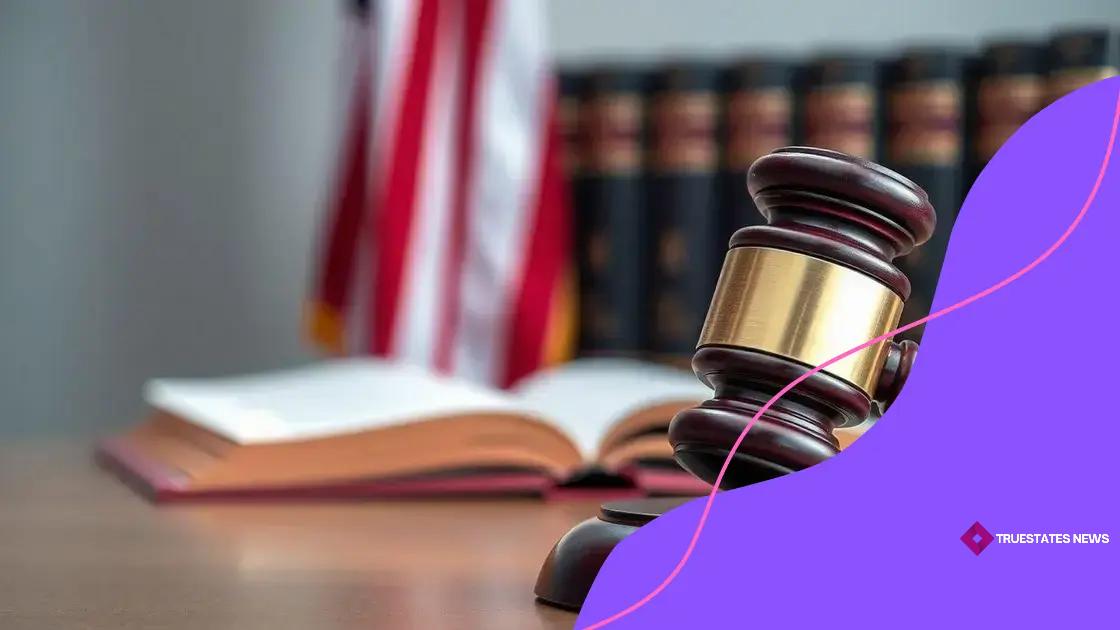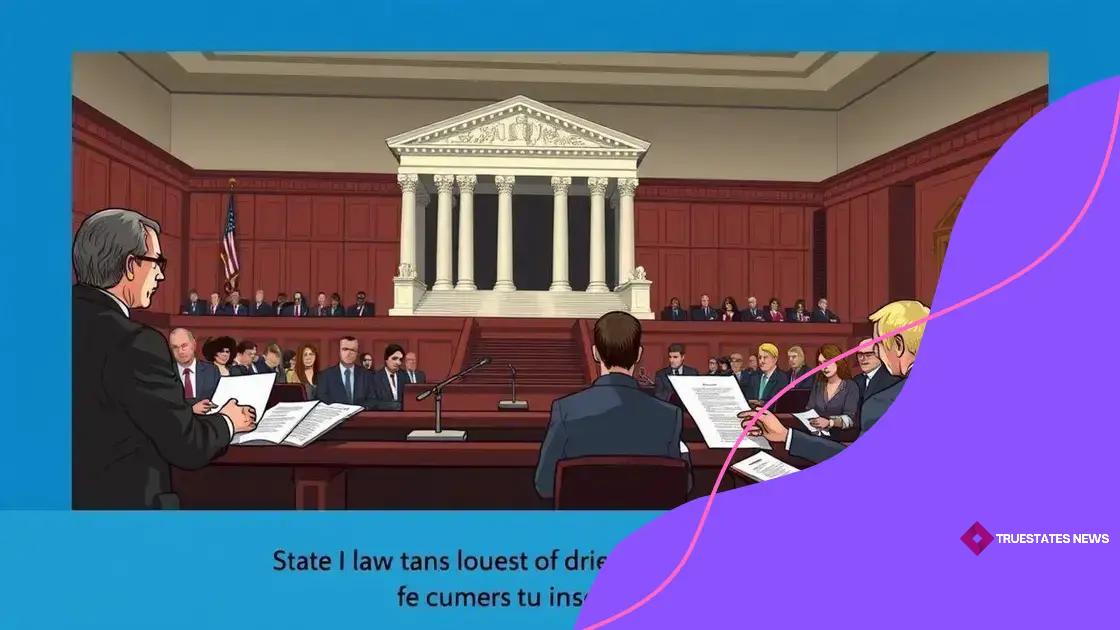Supreme Court decisions impact legislation: what you need to know

Supreme Court decisions impact legislation by establishing legal precedents, influencing state laws, and shaping social issues, ultimately affecting the rights and responsibilities of citizens nationwide.
Supreme Court decisions impact legislation in ways many might not realize. These rulings not only influence legal frameworks but also shape our daily lives.
Understanding the role of the Supreme Court
Understanding the role of the Supreme Court is essential for grasping how our legal system functions. The Court serves as the highest judicial authority in the United States and has the power to interpret the Constitution. Through its decisions, the Supreme Court influences various aspects of legislation and everyday life.
The Structure of the Supreme Court
The Supreme Court consists of nine justices who are nominated by the President and confirmed by the Senate. This body is responsible for hearing cases that can have nationwide implications. It reviews cases that involve significant legal or constitutional issues, allowing for a broader interpretation of laws.
Key functions of the Supreme Court include:
- Interpreting laws and the Constitution
- Resolving disputes between states
- Upholding federal laws
- Deciding on constitutional challenges
Each ruling made by the Supreme Court can set a precedent, which means it may influence future cases and legislation. The constitutionality of laws, especially those that affect civil rights or liberties, is often evaluated by this Court.
The Impact of Supreme Court Decisions
When the Supreme Court makes a ruling, it not only settles the specific case but can also reshape laws across the nation. For example, landmark decisions, such as Brown v. Board of Education, which ended racial segregation in schools, illustrate the Court’s power to drive social change.
Furthermore, these decisions often spark public debate and can impact political landscapes. The Supreme Court holds immense influence, making its understanding crucial for citizens who wish to engage meaningfully in societal issues.
In summary, the role of the Supreme Court is not limited to simply interpreting laws; it actively shapes the legislative landscape in significant ways. Through various rulings, it plays a vital role in the evolution of the United States legal system.
Key recent Supreme Court decisions
Key recent Supreme Court decisions have shaped the legal landscape in the United States. These rulings reflect important changes in societal values and address pressing issues. Understanding these cases helps to comprehend how laws evolve over time.
1. Dobbs v. Jackson Women’s Health Organization
In this critical decision, the Supreme Court overturned Roe v. Wade, which had guaranteed the right to abortion for nearly 50 years. This landmark ruling shifted the power to regulate abortion back to individual states. As a result, many states quickly enacted new laws that either restricted or protected abortion rights.
This case illustrates how the Supreme Court can directly impact personal rights and freedoms, reigniting debates about women’s health and autonomy.
2. New York State Rifle & Pistol Association Inc. v. Bruen
This 2022 ruling expanded gun rights by striking down a New York law that required individuals to show “proper cause” to carry a concealed firearm in public. The Court concluded that the Second Amendment guarantees an individual’s right to carry a handgun for self-defense. This decision has influenced similar laws across various states.
Continued discussions about public safety and gun control have emerged as a result of this ruling, highlighting the importance of the Court’s influence on **gun legislation**.
These key decisions demonstrate the power of the Supreme Court to transform laws and societal norms. Each ruling opens up discussions about the balance between individual rights and state regulations, shaping the future of U.S. law.
How Supreme Court rulings shape state laws

How Supreme Court rulings shape state laws is a pivotal aspect of the American legal system. The Court’s decisions can set precedents that states must follow, creating a ripple effect throughout the judicial landscape.
1. Legal Precedents
When the Supreme Court makes a decision, it often establishes a legal precedent. These precedents guide lower courts when they hear similar cases. For example, if the Supreme Court rules on a civil rights issue, states are required to align their laws with that decision.
This process ensures that a consistent legal framework is maintained across the country, though states may choose how to implement these rulings.
2. Areas of State Law Affected
Several areas of state law can be influenced by Supreme Court decisions:
- Education: Rulings can affect funding and policies in public schools.
- Voting Rights: Decisions may redefine voter access and election laws.
- Criminal Justice: The Court’s interpretations can alter sentencing guidelines and law enforcement practices.
- Healthcare: Supreme Court rulings can impact regulations surrounding health services and access.
Each ruling not only impacts existing laws but can also lead to the creation of new legislation in states. This dynamic interplay demonstrates the Supreme Court’s role as an active participant in the legislative process.
As we see changes at the national level, it’s clear that state laws must adapt in response to the directions set by the Supreme Court. Understanding this relationship is critical for citizens who wish to engage in their state’s legal and political processes.
The impact of Supreme Court decisions on social issues
The impact of Supreme Court decisions on social issues is profound and far-reaching. Many pivotal cases have shaped societal norms, influencing discussions and actions on issues like civil rights, marriage equality, and healthcare. These rulings often reflect changing public attitudes and can drive further change.
1. Civil Rights Movement
During the civil rights movement, several Supreme Court decisions helped dismantle racial segregation and discrimination. Cases such as Brown v. Board of Education in 1954 declared that state-sanctioned segregation in public schools was unconstitutional. This ruling was a turning point, energizing activists and legal efforts to promote equality.
2. Marriage Equality
The Supreme Court ruling in Obergefell v. Hodges in 2015 legalized same-sex marriage nationwide. This historic decision affirmed the rights of LGBTQ+ individuals and promoted acceptance across the country. It highlighted the Supreme Court‘s role in advancing social justice and equality.
These landmark decisions show how the Court can influence social issues, often reflecting or even leading public opinion. As societal values evolve, Supreme Court rulings can spark important conversations and further legislative changes.
3. Healthcare Access
More recently, rulings regarding healthcare rights have demonstrated the Court’s role in social issues. Decisions related to the Affordable Care Act (ACA) have impacted millions of Americans, influencing how healthcare is accessed and delivered.
As the Supreme Court navigates these complex social issues, it plays a significant part in shaping American life and values. Each decision not only has immediate effects but also resonates throughout society, encouraging dialogue and, in many cases, changes in policy.
Future implications of current Supreme Court decisions
The future implications of current Supreme Court decisions are significant and complex. As the Court navigates important cases today, the outcomes can shape laws and societal norms for years to come. Understanding these potential impacts is crucial for citizens and lawmakers alike.
1. Evolving Legal Standards
One of the primary implications of recent Supreme Court rulings is the evolution of legal standards. For example, as the Court addresses issues of privacy, free speech, and equal protection, they set the stage for how these rights will be interpreted in the future. This can lead to changes in policies at both the national and state levels.
2. Influence on State Legislation
Current decisions can also influence state legislation. When the Supreme Court rules on a significant legal matter, states often adjust their laws to comply with the new federal standards set by the Court. This means that changes at the federal level can have a direct impact on local laws and regulations.
For instance, rulings related to health care access or gun rights can prompt states to enact new laws or revise existing ones to align with the Supreme Court’s interpretations.
3. Social and Political Reactions
The social and political landscape is constantly shifting based on Supreme Court decisions. Landmark rulings often provoke public response, potentially leading to movements for further change. Activism can rise, encouraging new legislation or even attempts to amend the Constitution.
In summary, as we look ahead, the implications of current Supreme Court decisions are likely to affect everything from daily life to long-term legal frameworks. Keeping an eye on these trends is essential for those who want to engage in civic discourse and advocacy.
FAQ – Frequently Asked Questions about Supreme Court Decisions
How do Supreme Court decisions influence everyday life?
Supreme Court decisions shape laws that affect various aspects of daily life, including civil rights, healthcare, and education.
What kind of social issues do recent Supreme Court decisions address?
Recent decisions address issues like marriage equality, voting rights, and healthcare access, reflecting current societal values.
How do these decisions impact state laws?
Supreme Court rulings often require states to adjust their laws to comply with federal standards, leading to changes in local legislation.
Why is it important to stay informed about Supreme Court decisions?
Understanding these decisions helps citizens engage in important discussions and advocate for their rights within the legal system.
